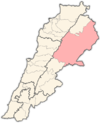Ard Tlaili
PPNB, Neolithic | |
| Site notes | |
|---|---|
| Excavation dates | 1965-1966 |
| Archaeologists | Lorraine Copeland, Peter J. Wescombe, Diana Kirkbride |
| Condition | ruins |
| Public access | Yes |
Ard Tlaili or Tell Ard Tlaili is a small
IIt was first surveyed and studied in 1965–66 by Lorraine Copeland and Peter Wescombe with excavations later in the 1960s by Diana Kirkbride.[3] The perimeter of the mound was buried under a metre of soil but the remains of rectangular buildings were found in 2 phases. Building walls were of wall made of stiff earth or clay with pebble bases and large stones in the upper layers. The floors were layered with white plaster with plastered and even burnished walls. Hearths and other areas were constructed of plaster or clay.
The wide variety of materials recovered included a stone assemblage of tools,
The carbon 14 dating of charcoal from the different levels at Ard Tlaili gave a short date range between c. 5710 until c.5780 BC.[5][6]
References
- ^ Lorraine Copeland; P. Wescombe (1965). Inventory of Stone-Age sites in Lebanon. Imprimerie Catholique. Retrieved 15 March 2011.[permanent dead link]
- ^ Copeland, Lorraine, "Neolithic Village Sites in the South Beqaa Lebanon", Melanges de l'Université Saint-Joseph (Beirut Lebanon) Volume 45, (Pages 83-114), 1969.
- ^ Diana Kirkbride (1969). Early Byblos and the Beqaʻa. Retrieved 24 March 2011.
- ^ Moore, A.M.T. (1978). The Neolithic of the Levant. Oxford University, Unpublished Ph.D. Thesis. pp. 433–435.
- ^ University of Cologne, Radiocarbon Context Database entry on Ard Tliali
- ^ Kuijt, I. Bar-Yosef, Ofer., Radiocarbon Chronology for the Levantine Neolithic: Observations and Data, Radiocarbon, 36, 227-245, 19, 1994

